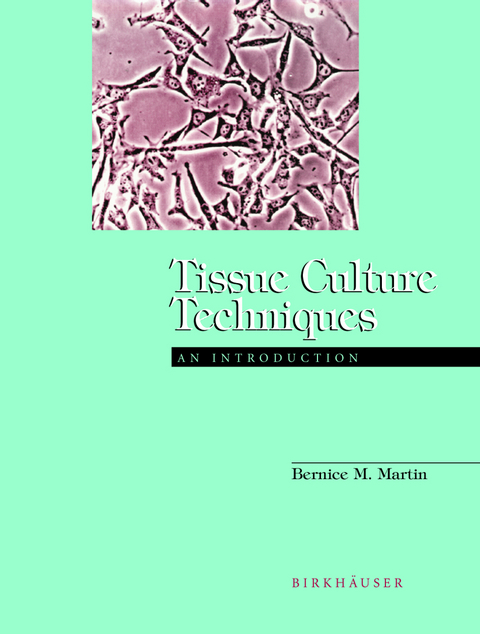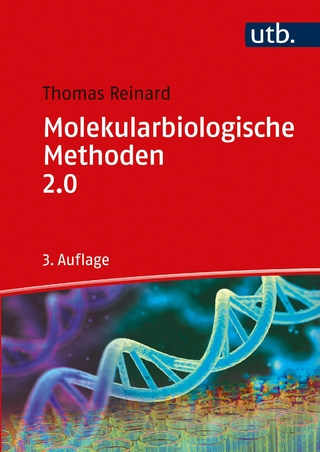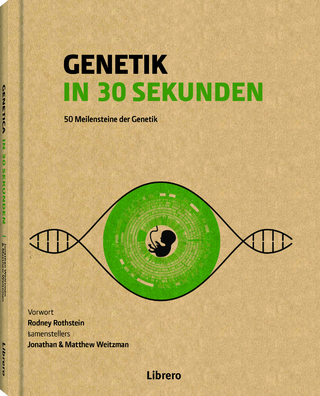
Tissue Culture Techniques
Birkhauser Boston Inc (Verlag)
978-0-8176-3643-2 (ISBN)
ACKNOWLEDGMENTS . . . . . . . . . . . . . . . . . . . . . . . . . . . . . . . . Xl II INTRODUCTION . . . . . . . . . . . . . . . . . . . . . . . . . . . . . . . . . . . . . I STERILITY . . . . . . . . . . . . . . . . . . . . . . . . . . . . . . . . . . . . . . . . . . . 5 Aseptic Technique . . . . . . . . . . . . . . . . . . . . . . . . . . . . . . . . . . . . . . . . . 5 Physical manipulations • Use of the sterile cabinet (hood) Sterilization Methods . . . . . . . . . . . . . . . . . . . . . . . . . . . . . . . . . . . . . 14 Heat • Radiation • Toxic gas • Filtration • Antibiotics Quality Control of Sterilization . . . . . . . . . . . . . . . . . . . . . . . . . . . . . 23 Routine labeling Suggested Readings . . . . . . . . . . . . . . . . . . . . . . . . . . . . . . . . . . . . . . . 25 Exercises . . . . . . . . . . . . . . . . . . . . . . . . . . . . . . . . . . . . . . . . . . . . . . . 26 vi CONTENTS ROUTINE CELL CULTURE . . . . . . . . . . . . . . . . . . . . . . . . . . . . 29 Feeding Schedules and Media Components . . . . . . . . . . . . . . . . . . . . 29 General properties of media and salt solutions • water as a reagent· Establishingfeeding schedules Subcultivation . . . . . . . . . . . . . . . . . . . . . . . . . . . . . . . . . . . . . . . . . . . 46 Solutions and methods for adherent cells • Common enzyme solutions • Inoculating (seeding) the cultures Cell Enumeration and Cell Viability . . . . . . . . . . . . . . . . . . . . . . . . . . 54 Hemocytometer • Particle counter • Cell viability Putting Routine Methods to Work . . . . . . . . . . . . . . . . . . . . . . . . . . . 63 Normal cell growth characteristics Detecting and Disposing of Contamination . . . . . . . . . . . . . . . . . . . . 66 Bacteria and fUngi • Fungi •Mycoplasma • Viruses • Dealing with contamination Troubleshooting . . . . . . . . . . . . . . . . . . . . . . . . . . . . . . . . . . . . . . . . . 73 Inadequate cell growth • Recurrent contamination • When to call your vendor Safety . . . . . . . . . . . . . . . . . . . . . . . . . . . . . . . . . . . . . . . . . . . . . . . . . 80 Biological hazards • Chemical hazards Suggested Readings . . . . . . . . . . . . . . . . . . . . . . . . . . . . . . . . . . . . . . . 85 Problem Set . . . . . . . . . . . . . . . . . . . . . . . . . . . . . . . . . . . . . . . . . . . . 85 Exercises . . . . . . . . . . . . . . . . . . . . . . . . . . . . . . . . . . . . . . . . . . . . . . . 89 EXPERIMENTS IN CULTURE . . . . . . . . . . . . . . . . . . . . . . . . . . 91 II Alterations of the Media . . . . . . . . . . . . . . . . . . . . . . . . . . . . . . . . . . . 91 Serum • Treatments of serum • Plasma-derived serum • Serum-free and low-protein media Substrata. . . . . . . . . . . . . . . . . . . . . . . . . . . . . . . . . . . . . . . . . . . . . . 101 Coatingplasticware with solutions • Alterations with polymers • Using cells to coat the plasticware • Culturing cells on microcarriers Altering the Environment. . . . . . . . . . . . . . . . . . . . . . . . . . . . . . . . . 106 Temperature changes • Gaseous changes Problem Set . . . . . . . . . . . . . . . . . . . . . . . . . . . . . . . . . . . . . . . . . . . 110 Exercises . . . . . . . . . . . . . . . . . . . . . . . . . . . . . . . . . . . . . . . . . . . . . . 110 CONTENTS vii PRIMARY CELL CULTURE. . . . . . . . . . . . . . . . . . . . . . . . . . . . 113 Isolation . . . . . . . . . . . . . . . . . . . . . . . . . . . . . . . . . . . . . . . . . . . . . . 114 Dissection • Enzymatic dissociation methods• Nonenzymatic isolation • Purification of cell suspensions • Consideringyield and survival Chatacterization . . . . . . . . . . . . . . . . . . . . . . . . . . . . . . . . . . . . . . . .
1 Introduction.- 2 Sterility.- Aseptic Technique.- Sterilization Methods.- Quality Control of Sterilization.- Suggested Readings.- Exercises.- 3 Routine Cell Culture.- Feeding Schedules and Media Components.- Subcultivation.- Cell Enumeration and Cell Viability.- Putting Routine Methods to Work.- Detecting and Disposing of Contamination.- Troubleshooting.- Safety.- Suggested Readings.- Problem Set.- Exercises.- 4 Experiments in Culture.- Alterations of the Media.- Substrata.- Altering the Environment.- Problem Set.- Exercises.- 5 Primary Cell Culture.- Isolation.- Characterization.- Exercise.- 6 Cell Preservation.- Freezing the Cells.- Thawing the Cells.- Problem Set.- 7 Cell Cloning.- Isolation.- Assisting Clonal Survival.- Problem Set.- 8 Culture Changes.- The Loss of Differentiated Phenotype.- Immortality and Aging.- Cell Transformation.- Transfection (Gene Transfer).- Suggested Readings.- Problem Set.- Exercises.- 9 Information for New Cell Studies.- Searching in the Literature.- Using Advertising and Catalogs.- References, Bibliographies, and Databases.- Appendices.- A The Cell Cycle.- Suggested Readings.- B Media and Salt Solutions.- Media.- Salt Solutions.- C Vendors.- D Glossary.- E Answers to Problem Sets and Exercises.
| Erscheint lt. Verlag | 1.8.1994 |
|---|---|
| Reihe/Serie | Tissue Culture Techniques. An Introduction | 1.10 |
| Zusatzinfo | 260 p. |
| Verlagsort | Secaucus |
| Sprache | englisch |
| Maße | 178 x 254 mm |
| Themenwelt | Medizin / Pharmazie ► Gesundheitswesen |
| Medizin / Pharmazie ► Medizinische Fachgebiete | |
| Naturwissenschaften ► Biologie ► Genetik / Molekularbiologie | |
| Naturwissenschaften ► Biologie ► Mikrobiologie / Immunologie | |
| Naturwissenschaften ► Biologie ► Zellbiologie | |
| ISBN-10 | 0-8176-3643-9 / 0817636439 |
| ISBN-13 | 978-0-8176-3643-2 / 9780817636432 |
| Zustand | Neuware |
| Haben Sie eine Frage zum Produkt? |
aus dem Bereich


